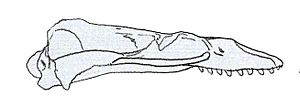Mammalodon facts for kids
Quick facts for kids Mammalodon |
|
|---|---|
 |
|
| Skull | |
| Scientific classification |
|
| Kingdom: | Animalia |
| Phylum: | Chordata |
| Class: | Mammalia |
| Order: | Artiodactyla |
| Infraorder: | Cetacea |
| Family: | †Mammalodontidae |
| Genus: | †Mammalodon Pritchard, 1939 |
| Species | |
|
|
Mammalodon was an ancient type of baleen whale that is now extinct. It belonged to a group of early whales called Mammalodontidae. Even though it's called a "baleen whale," Mammalodon actually had teeth, unlike modern baleen whales that use baleen plates to filter food.
Contents
What is Mammalodon?
Mammalodon lived about 25.7 to 23.9 million years ago, during a time called the Late Oligocene period. Its fossils have been found in Australia and New Zealand. The first Mammalodon fossil, an incomplete skull, was discovered in 1932 in Australia. Scientists named the species M. colliveri after Frederick Stanley Colliver, one of the people who found it. Later, a second species, M. hakataramea, was found in New Zealand.
When Mammalodon was first discovered, scientists thought it might be an even older type of whale called Archaeoceti. This was because it had different kinds of teeth in its jaw, which is a feature of very ancient whales, not modern ones. However, later studies showed that Mammalodon had other features, like a broad, flat roof of the mouth, that made it more like a baleen whale.
The name Mammalodon means "mammal tooth." This name was chosen because its molar teeth looked similar to the teeth of land-dwelling meat-eating mammals.
How Big Was Mammalodon?
Mammalodon was about 3 meters (10 feet) long, which is smaller than most modern baleen whales. It had a short, rounded snout, unlike the long, flat snouts of today's baleen whales.
Mammalodon's Unique Teeth
One of the most interesting things about Mammalodon was its teeth. It had different kinds of teeth in its mouth, including premolars and molars. The teeth in the back of its mouth got smaller. Its lower jaw had 24 teeth, all packed closely together.
Unlike modern whales, which usually have teeth that are all the same shape (or no teeth at all, like baleen whales), Mammalodon had teeth that varied in shape, especially in its lower jaw. It also had a few small incisor teeth at the front. Scientists believe Mammalodon kept the same set of teeth throughout its life, meaning they were never replaced.
Other Body Features
Only a few parts of Mammalodon's skeleton have been found. The second bone in its neck (called the axis) is preserved. Its breastbone was made of several pieces, similar to older whales but different from modern baleen whales. The bone that supported its tongue was also large and tube-shaped, unlike the flat tongue bones of today's whales. Its jawbones were likely fused together at the front, which is also different from later baleen whales.
What Did Mammalodon Eat?
Since Mammalodon had teeth and no baleen, it couldn't filter-feed like modern baleen whales do. This means its diet and how it found food are a bit of a mystery to scientists.
Because its teeth were somewhat spaced out, some scientists think it might have had a unique way of filter-feeding, different from other whales. One idea is that Mammalodon was a bottom filter feeder. Its blunt snout might have helped it suck up small organisms from the seafloor, acting like a vacuum cleaner for the ocean bottom.
See also
 In Spanish: Mammalodon para niños
In Spanish: Mammalodon para niños

